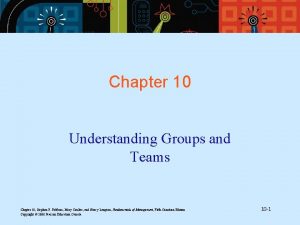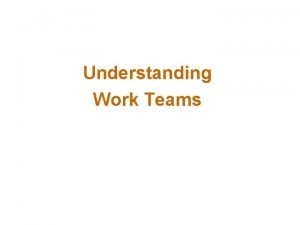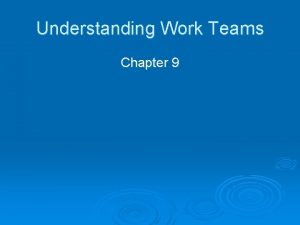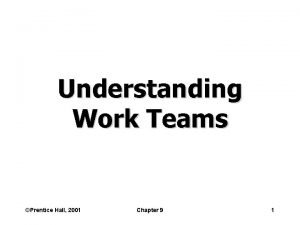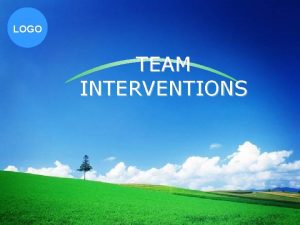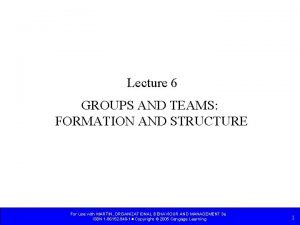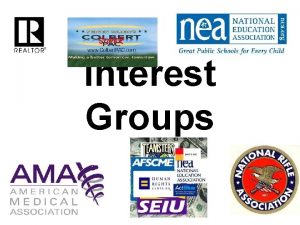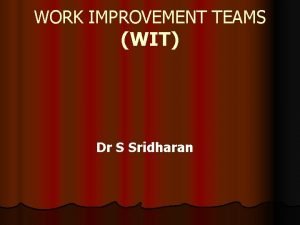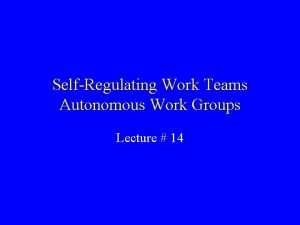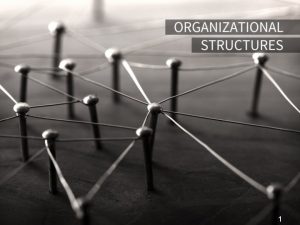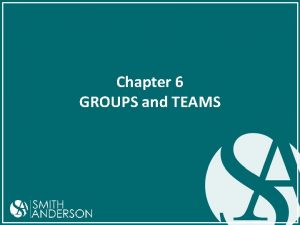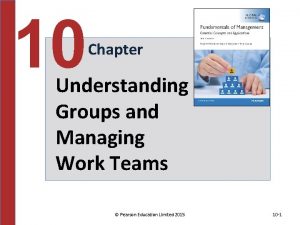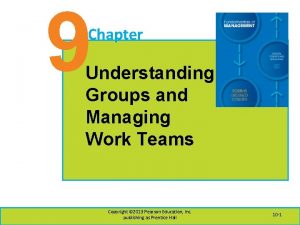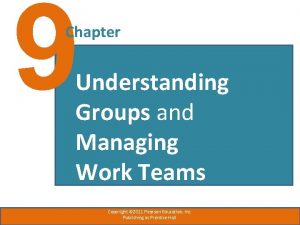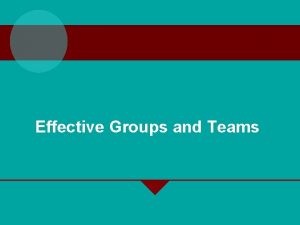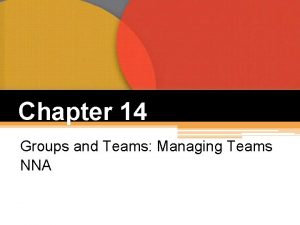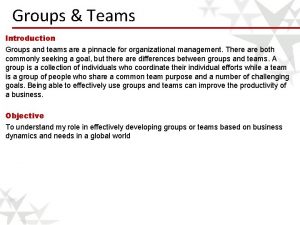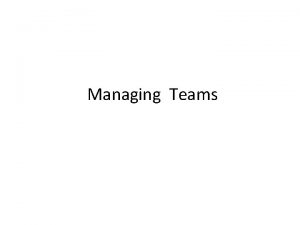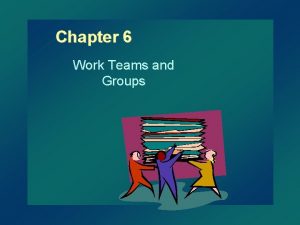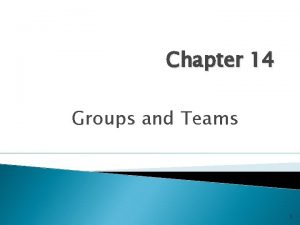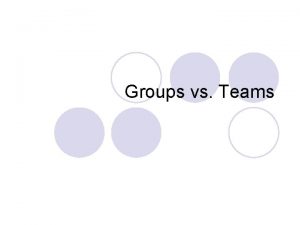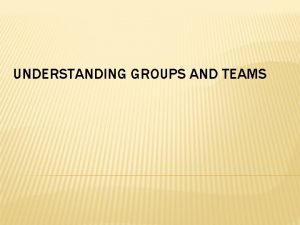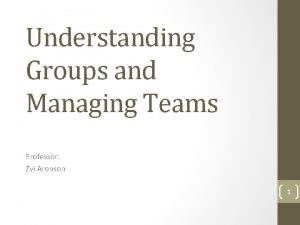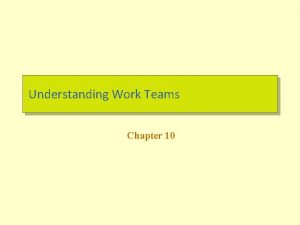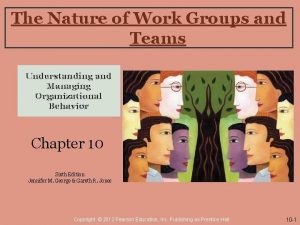10 Chapter Understanding Groups and Managing Work Teams






























- Slides: 30

10 Chapter Understanding Groups and Managing Work Teams Copyright © 2015 Pearson Education, Inc. 10 -1

Learning Outcomes • Define group and describe the stages of group development. • Describe the major concepts of group behavior. • Discuss how groups are turned into effective teams. • Discuss contemporary issues in managing teams. Copyright © 2015 Pearson Education, Inc. 10 -2

10. 1 Define group and describe the stages of group development. Copyright © 2015 Pearson Education, Inc. 10 -3

What is a Group? Copyright © 2015 Pearson Education, Inc. 10 -4

10. 2 Describe the major concepts of group behavior. Copyright © 2015 Pearson Education, Inc. 10 -5

Stages of Group Development Copyright © 2015 Pearson Education, Inc. 10 -6

Group Effectiveness Does a group become more effective as it progresses through the first four stages? Copyright © 2015 Pearson Education, Inc. 10 -7

Group Behavior Copyright © 2015 Pearson Education, Inc. 10 -8

Norms Copyright © 2015 Pearson Education, Inc. 10 -9

Conformity Copyright © 2015 Pearson Education, Inc. 10 -10

Status Systems Status A prestige grading, position, or rank within a group. Copyright © 2015 Pearson Education, Inc. 10 -11

Group Size and Group Behavior Copyright © 2015 Pearson Education, Inc. 10 -12

Group Cohesiveness Copyright © 2015 Pearson Education, Inc. 10 -13

10. 3 Discuss how groups are turned into effective teams. Copyright © 2015 Pearson Education, Inc. 10 -14

Groups Versus Teams Copyright © 2015 Pearson Education, Inc. 10 -15

Types of Work Teams 1. 2. 3. 4. Problem solving teams Self-managed work teams Cross-functional teams Virtual teams Copyright © 2015 Pearson Education, Inc. 10 -16

Virtual Teams A type of work team that uses technology to link physically dispersed members in order to achieve a common goal. Copyright © 2015 Pearson Education, Inc. 10 -17

Effective Teams Copyright © 2015 Pearson Education, Inc. 10 -18

Team Composition Copyright © 2015 Pearson Education, Inc. 10 -19

Team Member Roles Copyright © 2015 Pearson Education, Inc. 10 -20

Work Design Key work design elements: 1. Autonomy 2. Using a variety of skills 3. Completing a whole and identifiable task 4. Impact of task/project on others Copyright © 2015 Pearson Education, Inc. 10 -21

Team Processes Variables related to effectiveness: 1. Common plan/purpose 2. Specific goals 3. Team efficacy 4. Task conflict 5. Minimal social loafing Copyright © 2015 Pearson Education, Inc. 10 -22

Shaping Team Behavior • Member selection is key • Teamwork training Copyright © 2015 Pearson Education, Inc. 10 -23

Rewards External rewards: • Promotions • Pay raises • Other forms of recognition Inherent rewards: • Camaraderie • Personal development • Helping teammates Copyright © 2015 Pearson Education, Inc. 10 -24

10. 4 Discuss contemporary issues in managing teams. Copyright © 2015 Pearson Education, Inc. 10 -25

Contemporary Issues Copyright © 2015 Pearson Education, Inc. 10 -26

Global Teams: Team Structure • • Conformity Status Social loafing Cohesiveness Copyright © 2015 Pearson Education, Inc. 10 -27

Global Teams: Team Processes • Communication issues • Managing conflict • Virtual teams Copyright © 2015 Pearson Education, Inc. 10 -28

When Teams are Not the Answer Three tests: 1. Can the work be done better by more than one person? 2. Does the work create a common purpose that’s more than the sum of individual goals? 3. Is there interdependence between tasks? Copyright © 2015 Pearson Education, Inc. 10 -29

10 -30
 Understanding groups and managing work teams
Understanding groups and managing work teams Understanding groups and teams
Understanding groups and teams Understanding groups and teams
Understanding groups and teams Teams typically outperform individuals
Teams typically outperform individuals Teams typically outperform individuals
Teams typically outperform individuals Why have teams become so popular
Why have teams become so popular Understanding work teams
Understanding work teams What's the difference between group and team
What's the difference between group and team Groups and teams difference
Groups and teams difference Groups and teams difference
Groups and teams difference Understanding and managing clinical risk
Understanding and managing clinical risk How are ethnic groups and religious groups related
How are ethnic groups and religious groups related For or against
For or against Motivating and satisfying employees and teams
Motivating and satisfying employees and teams Chapter 10 motivating and satisfying employees and teams
Chapter 10 motivating and satisfying employees and teams Section 4 review physical science
Section 4 review physical science Work improvement teams
Work improvement teams Autonomous work teams
Autonomous work teams Workgroups are characterized by
Workgroups are characterized by Remedial model example
Remedial model example Structures are laid-back and undefined.
Structures are laid-back and undefined. Making small groups work
Making small groups work Motivating and satisfying employees and teams
Motivating and satisfying employees and teams Motivating and satisfying employees and teams
Motivating and satisfying employees and teams Copyright
Copyright Chapter 8 managing stress and anxiety
Chapter 8 managing stress and anxiety Chapter 4 managing stress and coping with loss
Chapter 4 managing stress and coping with loss Chapter 6 managing weight and body composition
Chapter 6 managing weight and body composition Why should teen athletes avoid performance enhancers?
Why should teen athletes avoid performance enhancers? Chapter 11 lesson 1 maintaining a healthy weight
Chapter 11 lesson 1 maintaining a healthy weight Management chapter 1
Management chapter 1


